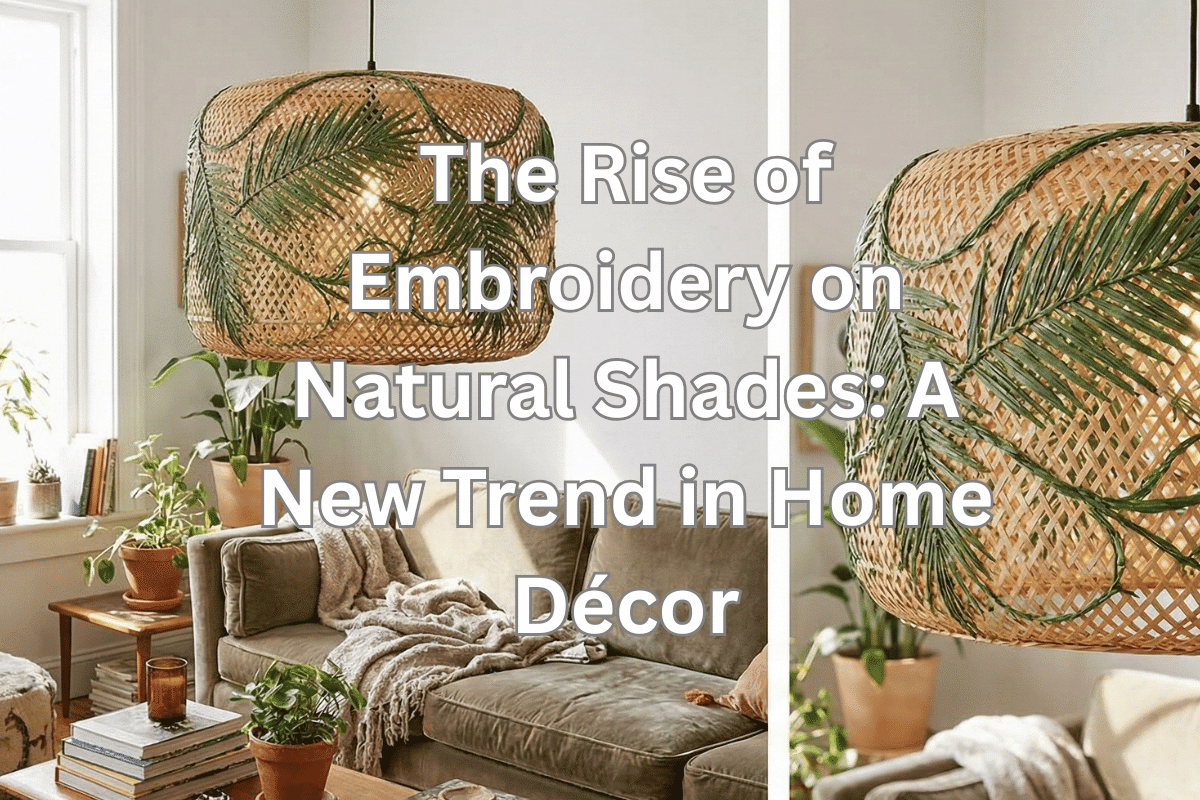In the world of design, trends often evolve as a fusion of fashion, tradition, and innovation.
One of the most exciting trends we are seeing now is the rise of embroidery on many kinds of objects including on natural shades. This unique combination of traditional craftsmanship with natural materials is not only reshaping the way we think about home décor but also bringing a fresh, handmade touch to interiors. From intricate floral patterns to simple, minimalist designs, embroidered natural shades are making a bold statement in modern homes.
Table of Contents
- The Influence of Fashion on Home Décor
- The Process Behind the Craft
- The Psychological Benefits of Embroidered Natural Shades
- Bringing a New Look to Natural Shades
- Deep Dive Podcast
- Related Content
So, why are we doing embroidery on natural shades, and why is this trend gaining so much traction? To answer this, we need to look at the broader design landscape, where embroidery has been making waves in unexpected places.
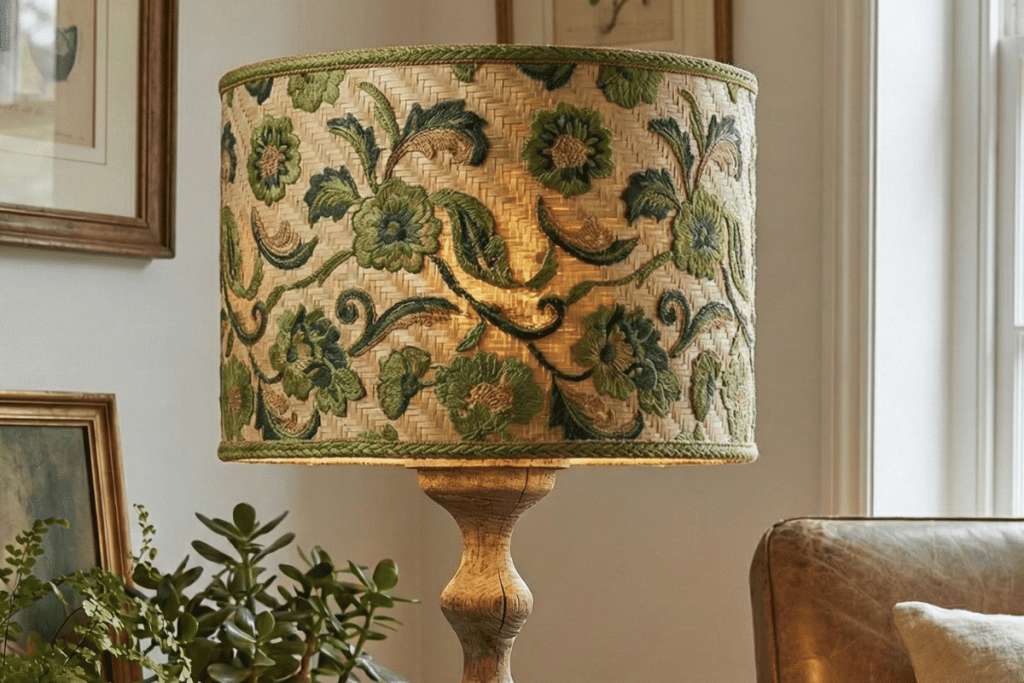
The Influence of Fashion on Home Décor
Fashion has always been a significant influence on home décor trends, and embroidery is no exception. Recently, we’ve seen embroidery making a strong comeback in the world of high-end fashion.
Designers like Louis Vuitton and Valentino have embraced embroidery in their collections, adorning purses, bags, and accessories with intricate details such as flowers, leaves, and other organic motifs. These pieces are not only beautiful but also exude a sense of artistry and craftsmanship that resonates with consumers seeking something unique and personal.
Embroidery has also been a standout on the fashion runway, where designers are pushing the boundaries of creativity by incorporating it into unexpected pieces. From embroidered jackets to dresses and even shoes, this art form is being celebrated for its ability to add texture, depth, and a handmade feel to otherwise modern designs.
This resurgence of embroidery in fashion has inspired other industries, including home décor.
Just as we’re seeing embroidered bags and clothing become a staple in high-end fashion, we believe that embroidery on natural shades is the next big thing in interiors. It’s a natural progression—what works beautifully in fashion often translates seamlessly into the home décor space.
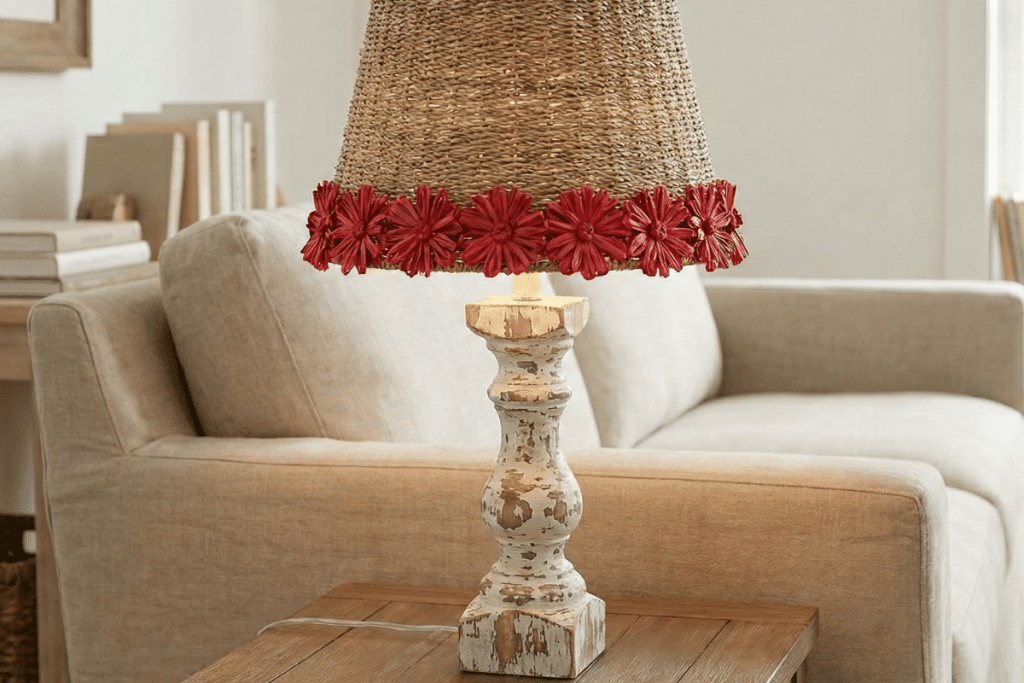
Why Embroidery on Natural Shades?
At its core, embroidery on natural shades combines two key elements: nature and craftsmanship. By using natural materials like bamboo, water hyacinth, and seagrass as the foundation, these shades already bring an organic, earthy vibe to any space.
Adding embroidery enhances this natural beauty with intricate, artistic details, creating a look that feels both timeless and contemporary.
Here are some of the reasons why embroidery on natural shades is such an exciting trend:
1. A Handmade Touch
One of the most unique aspects of embroidered natural shades is the fact that the embroidery is done entirely by hand.
Unlike machine embroidery, which can feel impersonal and overly uniform, hand embroidery brings a sense of warmth and individuality to each piece. Every stitch tells a story, and no two shades are exactly alike.
This level of craftsmanship requires skilled artisans who understand the delicate balance between the natural materials and the embroidery itself. In Vietnam, where this technique is being perfected, artisans use their expertise to create stunning designs that elevate natural shades to works of art.
2. Versatility in Design
Embroidery on natural shades offers endless possibilities when it comes to design. Whether you prefer a shade filled with vibrant, colorful flowers or a more minimalist look featuring simple embroidered leaves, there’s something for everyone.
For example:
- A floral-themed shade can bring a touch of spring into your home year-round, adding warmth and charm to any room.
- A geometric or abstract design can create a modern, artistic vibe that complements contemporary interiors.
- Simple leaf patterns can evoke a sense of calm and nature, perfect for a relaxing bedroom or living space.
This versatility makes embroidered natural shades suitable for a wide range of styles and settings, from bohemian to minimalist to eclectic.
3. Natural Materials as a Canvas
The choice of materials is crucial when it comes to embroidery on natural shades. Bamboo, water hyacinth, and seagrass are the primary materials used because they provide the perfect balance of durability and flexibility. These materials are sturdy enough to hold the embroidery but also soft enough to allow the needlework to shine.
Additionally, these natural materials are sustainable and eco-friendly, making them an excellent choice for environmentally conscious consumers. By combining sustainability with artistry, embroidered natural shades offer a way to decorate your home while staying mindful of the planet.
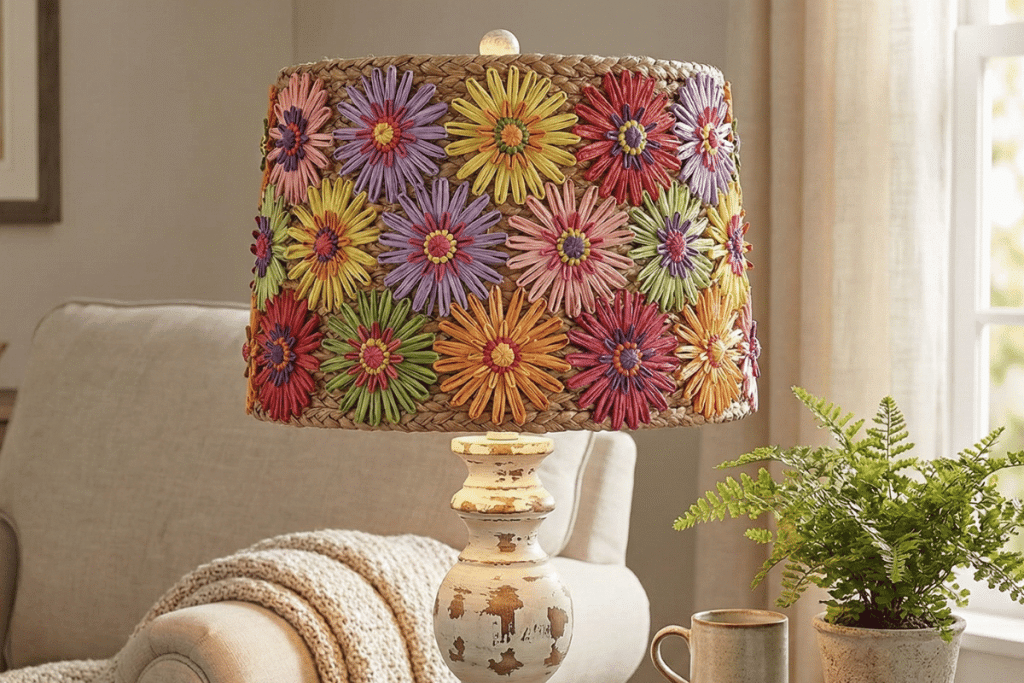
The Process Behind the Craft
Creating embroidered natural shades is a labor-intensive process that requires a high level of skill and attention to detail. Here’s a glimpse into how it’s done:
- Material Selection
The first step is choosing the right natural material for the shade. Bamboo, water hyacinth, and seagrass are carefully selected for their texture, color, and ability to hold embroidery. - Design Creation
Next, the design is planned. This could be anything from a detailed floral arrangement to a minimalist pattern. The designs are often inspired by nature, with motifs like flowers, leaves, and vines being particularly popular. - Hand Embroidery
Once the design is finalized, skilled artisans begin the embroidery process. Using materials like yarns or paper raffia, they carefully stitch the design onto the natural shade. This step requires precision and patience, as the embroidery must complement the natural texture of the shade without overpowering it. - Finishing Touches
Finally, the shade is inspected for quality and any finishing touches are added. The result is a one-of-a-kind piece that combines natural beauty with artistic craftsmanship.
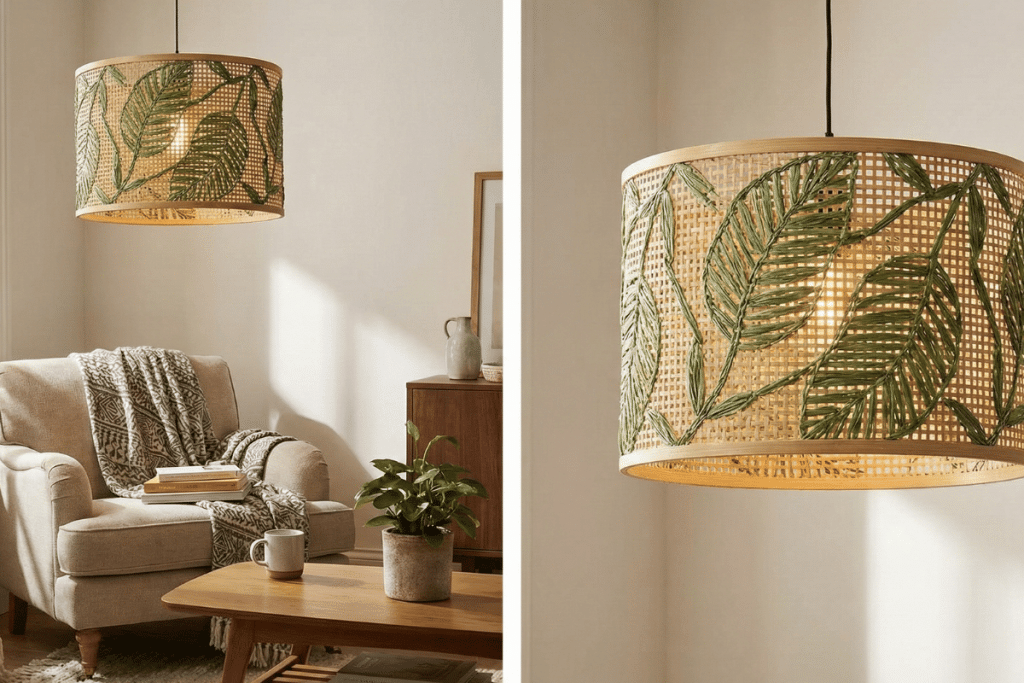
The Psychological Benefits of Embroidered Natural Shades
Beyond their aesthetic appeal, embroidered natural shades also offer psychological benefits that make them a valuable addition to any home.
1. Increased Creativity
The intricate designs and textures of embroidered shades can inspire creativity and imagination. Whether you’re working in a home office or relaxing in a living room, these shades can spark ideas and help you think outside the box.
2. A Sense of Calm
Natural materials have a grounding effect that can help reduce stress and promote relaxation. When combined with the soothing patterns of embroidery, these shades create a tranquil atmosphere that’s perfect for unwinding after a long day.
3. Connection to Nature
Incorporating natural materials and designs into your home can help you feel more connected to the outdoors, even when you’re inside. This connection to nature has been shown to improve mood and overall well-being.
Bringing a New Look to Natural Shades
At its heart, embroidery on natural shades is about bringing a fresh perspective to a classic design. Natural shades have long been a popular choice for their simplicity and versatility, but embroidery takes them to a whole new level.
This trend is not just about aesthetics—it’s about storytelling. Each embroidered shade tells a story of craftsmanship, tradition, and creativity. Whether used as a pendant light or as a shade for a lamp base, these pieces bring a sense of artistry and personality to any space.
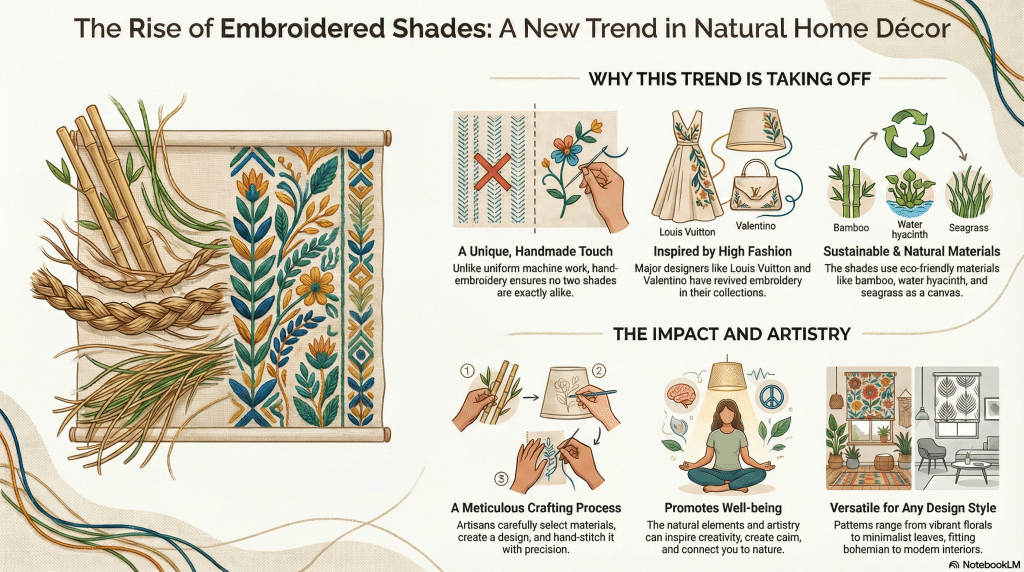
How to Incorporate Embroidered Natural Shades into Your Home
If you’re looking to embrace this trend, here are some tips for incorporating embroidered natural shades into your home:
- Choose a Focal Point
Use an embroidered natural shade as a statement piece in a room. For example, a large pendant light with floral embroidery can serve as the centerpiece of a dining room or living area. - Mix and Match
Don’t be afraid to mix embroidered shades with other natural elements, such as wooden furniture, woven rugs, or potted plants. This creates a cohesive, earthy look that feels inviting and harmonious. - Experiment with Patterns
Try different embroidery patterns to match your personal style. If you prefer a minimalist look, opt for shades with simple, understated designs. For a more eclectic vibe, choose shades with bold, colorful embroidery. - Layer Lighting
Use embroidered shades in combination with other lighting elements to create a layered effect. For example, pair a floor lamp with an embroidered shade with recessed lighting or wall sconces for a dynamic, well-lit space.
Embroidery on natural shades is more than just a trend—it’s a celebration of craftsmanship, creativity, and nature. By combining traditional techniques with sustainable materials, this unique design approach brings a fresh, handmade touch to home décor.
As we continue to see embroidery gaining popularity in fashion and other industries, it’s clear that this art form has a timeless appeal. Whether you’re drawn to intricate floral patterns or simple, minimalist designs, embroidered natural shades offer a way to express your personal style while adding warmth and character to your home.
So, embrace this trend and let the beauty of embroidered natural shades transform your space. After all, there’s nothing quite like the charm of something handmade, unique, and inspired by nature.
If you are interested to explore having natural embroidery shades for your home decor or home furniture collection, please contact Anita at Mondoro by clicking here.
Deep Dive Podcast
Check out our podcast to learn more.
If you are interested in seeing how Mondoro can be a valuable partner for you for wood furniture products – we would love to talk to you to see how we can help you.
Find out more about how Mondoro can help you create, develop, and manufacture excellent home decor and furniture products – don’t hesitate to contact me, Anita. Check out my email by clicking here or become a part of our community and join our newsletter by clicking here.
Mondoro gives out a FREE Lookbook to anyone interested. You can receive a copy of our latest Lookbook by clicking here.
Listen to our Podcast called Global Trade Gal. You can find it on all major podcast platforms. Try out listening to one of our podcasts by clicking here.
Subscribe to our Mondoro Company Limited YouTube Channel filled with great videos and information by clicking here.
Related Content
Difference Between Solid Sheesham Wood, And Teak Wood
Solid Sheesham Wood and Teak Wood are both very different kinds of woods. Even though they are both considered hardwoods, Sheesham wood is softer than teak. Sheesham wood is also considered less durable than teak wood. Many premier manufacturers consider teak wood the ”king of woods.”
You can discover more by reading Difference Between Solid Sheesham Wood, And Teak Wood by clicking here.
Is Teak a Coniferous, Evergreen, or Deciduous Tree? 11 Teak Wood Facts
Teak is a deciduous, not evergreen or coniferous tree. Teak leaves do not fall off in the wintertime, but they fall off in the dry season; in Asia, where teak trees are naturally grown, the dry season is not always the same as winter. As the teak leaves do fall off, the tree is considered to be a deciduous tree.
You can discover more by reading our blog Is Teak a Coniferous, Evergreen, or Deciduous Tree? 11 Teak Wood Facts by clicking here.
What Are The Types Of Wood Used In Furniture?
Wood for furniture is divided up into hard and softwood. Though the woods have some similarities, they also have some differences. Different looks and types of furniture may require a certain kind of wood. Some wood species will be higher priced, and others will be cheaper; price, durability, look, color, finish, and structure can decide what wood to choose for your furniture piece.
You can discover more by reading our blog What Are The Types Of Wood Used In Furniture? by clicking here.

